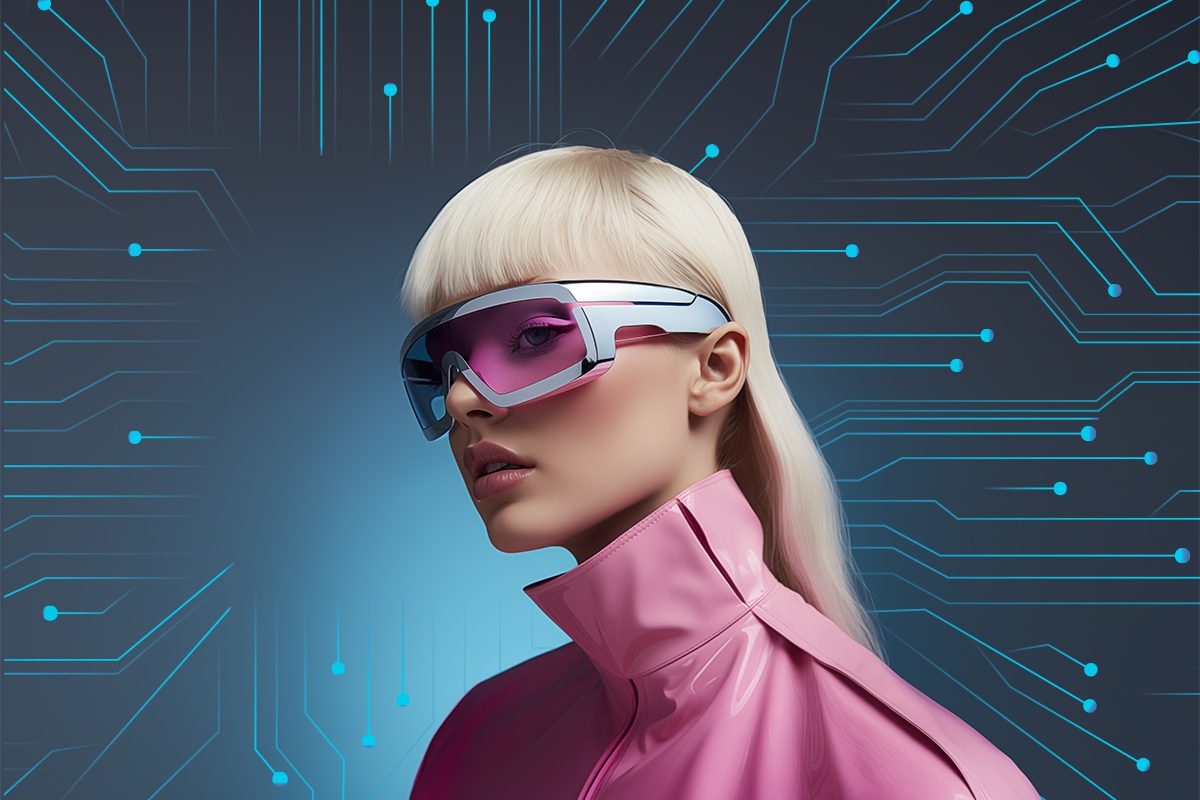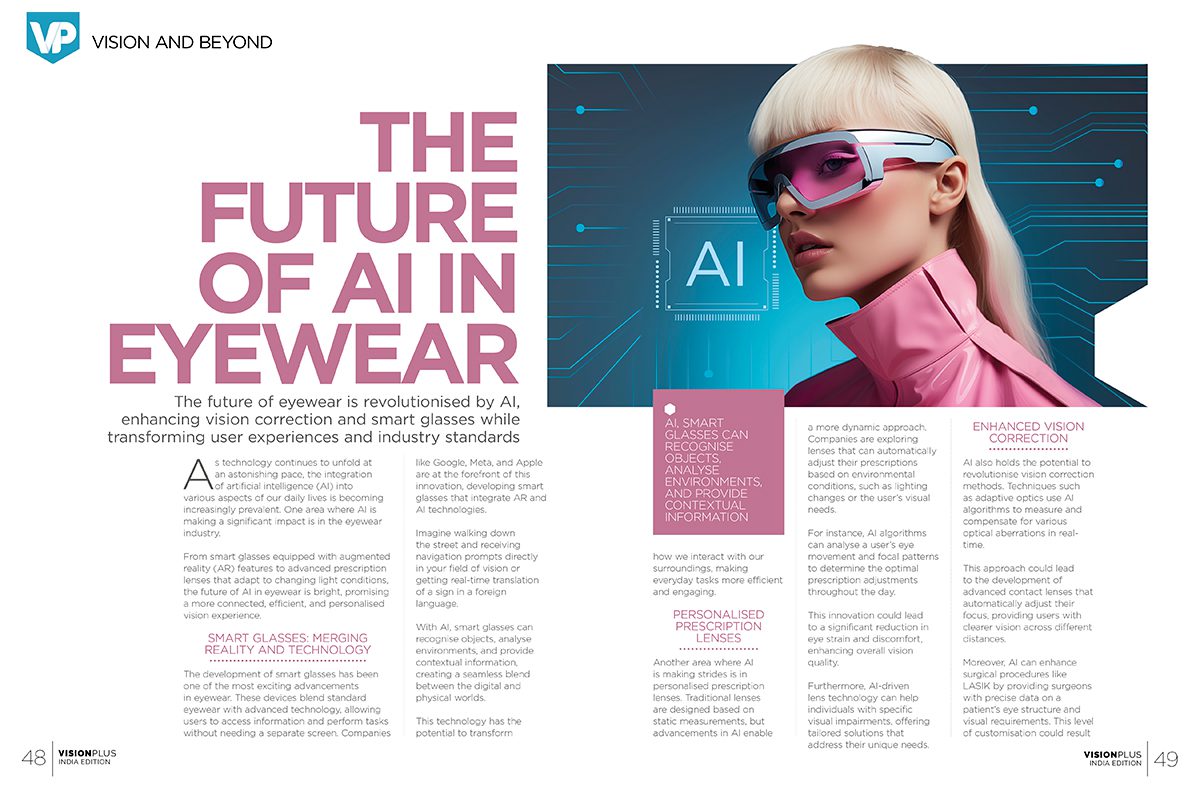
The Future of AI In Eyewear
The future of eyewear is revolutionised by AI, enhancing vision correction and smart glasses while transforming user experiences and industry standards
As technology continues to unfold at an astonishing pace, the integration of artificial intelligence (AI) into various aspects of our daily lives is becoming increasingly prevalent. One area where AI is making a significant impact is in the eyewear industry.
From smart glasses equipped with augmented reality (AR) features to advanced prescription lenses that adapt to changing light conditions, the future of AI in eyewear is bright, promising a more connected, efficient, and personalised vision experience.
Smart Glasses: Merging Reality and Technology
The development of smart glasses has been one of the most exciting advancements in eyewear. These devices blend standard eyewear with advanced technology, allowing users to access information and perform tasks without needing a separate screen. Companies like Google, Meta, and Apple are at the forefront of this innovation, developing smart glasses that integrate AR and AI technologies.
Imagine walking down the street and receiving navigation prompts directly in your field of vision or getting a real-time translation of a sign in a foreign language.
With AI, smart glasses can recognise objects, analyse environments, and provide contextual information, creating a seamless blend between the digital and physical worlds.
This technology has the potential to transform how we interact with our surroundings, making everyday tasks more efficient and engaging.
Personalised Prescription Lenses
Another area where AI is making strides is in personalised prescription lenses. Traditional lenses are designed based on static measurements, but advancements in AI enable a more dynamic approach. Companies are exploring lenses that can automatically adjust their prescriptions based on environmental conditions, such as lighting changes or the user’s visual needs.
For instance, AI algorithms can analyse a user’s eye movement and focal patterns to determine the optimal prescription adjustments throughout the day.
This innovation could lead to a significant reduction in eye strain and discomfort, enhancing overall vision quality.
Furthermore, AI-driven lens technology can help individuals with specific visual impairments, offering tailored solutions that address their unique needs.
Enhanced Vision Correction
AI also holds the potential to revolutionise vision correction methods. Techniques such as adaptive optics use AI algorithms to measure and compensate for various optical aberrations in real-time.
This approach could lead to the development of advanced contact lenses that automatically adjust their focus, providing users with clearer vision across different distances.
Moreover, AI can enhance surgical procedures like LASIK by providing surgeons with precise data on a patient’s eye structure and visual requirements. This level of customisation could result in better surgical outcomes and a higher overall satisfaction rate among patients seeking vision correction.
 Data-Driven Insights for Eye Health
Data-Driven Insights for Eye Health
As smart eyewear becomes more commonplace, the data collected from users will offer valuable insights into eye health and wellness. AI can analyse this data to identify patterns and trends, allowing for early detection of potential eye conditions or changes in vision.
For example, smart glasses equipped with sensors can track a user’s screen time, lighting conditions, and eye strain levels. By analysing this data, AI can provide personalised recommendations for eye care, such as taking breaks, adjusting screen brightness, or visiting an eye care professional.
This proactive approach to eye health has the potential to reduce the incidence of common vision problems and improve overall well-being.
Accessibility And Inclusivity
The integration of AI in eyewear is also paving the way for greater accessibility and inclusivity.
For individuals with visual impairments, AI-powered smart glasses can enhance their ability to navigate the world. Features such as object recognition, facial recognition, and audio descriptions can provide
real-time assistance, making it easier for visually impaired users to interact with their environment.
Moreover, AI can facilitate the development of customised eyewear solutions for diverse populations. By analysing user data, companies can create products that cater to various visual needs, ensuring that everyone has access to effective eyewear options.
Looking ahead, the future of AI in eyewear will likely involve a collaborative ecosystem where eyewear devices connect with smartphones, smartwatches, and other digital interfaces.
As AI technology continues to advance, we can expect to see the emergence of features such as gesture control, voice recognition, and even biometric tracking integrated into eyewear.
These innovations will not only make eyewear more user-friendly but also open up new possibilities for how we interact with technology in our daily lives.
The future of AI in eyewear is full of promise, offering a glimpse into a world where technology enhances our vision experience and improves eye health. From smart glasses that merge reality with digital information to personalised prescription lenses and advanced vision correction methods, the potential applications are vast and exciting.
As we move forward, it is essential for companies to prioritise user experience, accessibility, and data privacy while developing these innovative solutions.
By doing so, the eyewear industry can usher in a new era of AI-driven technology that not only transforms how we see but also enriches our lives in meaningful ways. The integration of AI in eyewear is just beginning, and the possibilities are boundless.







